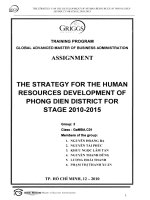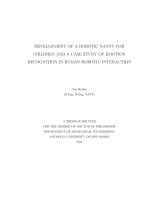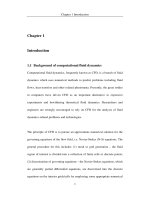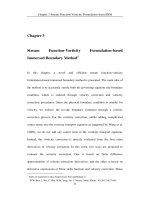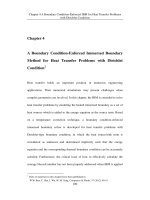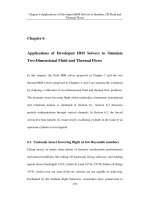Development of cell sheet constructs for layer by layer tissue engineering using the blood vessel as an experimental model 1
Bạn đang xem bản rút gọn của tài liệu. Xem và tải ngay bản đầy đủ của tài liệu tại đây (9.38 MB, 140 trang )
Development of Cell-Sheet Constructs for
Layer-by-Layer Tissue Engineering Using
the Blood Vessel as an Experimental Model
Chong Seow Khoon, Mark
(B.Eng, National University of Singapore)
A THESIS SUBMITTED FOR THE DEGREE OF
DOCTOR OF PHILOSOPHY
GRAUDATE PROGRAM IN BIOENGINEERING
NATIONAL UNIVERSTY OF SINGAPORE
2009
Preface
Preface
This thesis is submitted for the degree of Doctor of Philosophy in the Graduate
Program in Bioengineering at the National University of Singapore under the
supervision of Professor Lee Chuen Neng, Professor Teoh Swee Hin and Dr Jerry
Chan. No part of this thesis has been submitted for other degree or diploma at other
universities or institutions. To the author’s best knowledge, all the work presented in
this thesis is original unless reference is made to other works. Parts of this thesis have
been published or presented in the following:
International Journal Publications
1. Chong, MSK, CN Lee and SH Teoh (2007). "Characterization of smooth muscle
cells on poly([epsilon]-caprolactone) films." Materials Science and
Engineering: C 27(2): 309-312.
2. Chong, MS, J Chan, M Choolani, CN Lee and SH Teoh (2009). "Development of
cell-selective films for layered co-culturing of vascular progenitor cells."
Biomaterials 30(12): 2241-51.
3. Zhang, ZY, SH Teoh, MS Chong, JT Schantz, NM Fisk, MA Choolani and J Chan
(2009). "Superior Osteogenic Capacity for Bone Tissue Engineering of Fetal
Compared To Perinatal and Adult Mesenchymal Stem Cells." Stem Cells
27(1): 126-37.
4. Lee, ES, J Chan, B Shuter, LG Tan, MS Chong, DL Ramachandra, GS Dawe, J
Ding, SH Teoh, O Beuf, A Briguet, KC Tam, M Choolani and S-C Wang
(2009). "Microgel Iron Oxide Nanoparticles For Tracking Human Fetal
Mesenchymal Stem Cells Through Magnetic Resonance Imaging." Stem Cells
(In press)
5. Tan K, Tang K, Huang S, Putra A, Lee T, Ng S, Chan J, Tan L, Chong M. (2009)
Ex-Utero Harvest of Haematopoietic Stem Cells from Placenta/Umbilical
Cord with an Automated Collection System. IEEE Trans Biomed Eng
6. Chong, MS, SH Teoh, EYL Teo, CN Lee, S Koh, M Choolani, and J Chan "CD34
antibody conjugation onto µXPCL film surfaces contributes to
haemocompatibility by reducing procoagulatory responses" Biomaterials
(submitted)
Book Chapters
1. Chan J, Chong MS. Lentiviral vector transduction of human fetal mesenchymal
stem cells In: Federico M, editor. Lentivirus Gene Engineering Protocols;
2009
i
2. Teoh SH, Rai B, Tiaw KS, Chong MSK, Zhang Z, Teo YE. Nano-to-macro
architectures polycaprolactone-based biomaterials in tissue engineering. In:
Tateishi T, editor. Biomaterials in Asia; 2009
ii
Abstract
Cell sheet tissue engineering approaches have recently emerged as a method to
generate stratified tissue and better recapitulate native architecture. However,
completely biological cell sheet approaches are limited by poor mechanical strength
and appropriate substrate cues for modulating cell responses. The development of
microthin polycaprolactone (PCL) films raised the possibility of using these films as
scaffolds to complement the cell sheet approach. The aim of the present thesis was to
investigate the use of PCL films as scaffolds in layered tissue engineering, using the
blood vessel as a model. The scope covers the engineering of microthin PCL films
using bi-axial stretching and surface modification, isolation of vascular progenitor
cells and in vitro evaluation of the engineered films.
It was found that solvent cast and electrospun microthin PCL films did not compare
favourably against biaxially stretched PCL films (µXPCL). The latter was found to
possess the highest tensile strength and resistance to chemical degradation as
determined by erosion assays. Tubular constructs formed from µXPCL were found to
possess adequate burst pressure and slow degradation (as determined by DSC and
SEM studies), and were predicted to retain tensile properties capable of withstanding
physiological loads for up to twelve weeks in vivo.
A novel glow-discharge plasma immobilisation technique was used to functionalise
the µXPCL film with carboxyl or amine groups, which allowed the conjugation of a
range of biological moieties. Conjugation of common model proteins, including
iii
collagen and cell-capture antibodies, was demonstrated, underlining the possibility of
generating customised surfaces for layered tissue engineering.
Subsequently, perivascular cells derived from umbilical cord (UCPVC) were found
suitable for reconstruction of the perivascular compartment for vascular tissue
engineering. Endothelial progenitor cells (EPCs) were found to exist in perinatal
haematopoietic tissue, including two novel sources (fetal blood and liver). In
particular, fetal blood derived EPC suggest superior vasculogenic capacity in Matrigel
and microarray studies. However, umbilical cord blood EPC (UCB-EPC) were
deemed the most suitable for vascular tissue engineering due to lineage stability.
The feasibility of microthin PCL films for layered vascular tissue engineering was
explored. µXPCL film surfaces were modified to support UCPVC and UCB-EPC for
the perivascular and intimal compartments respectively. In addition, the intimal
surface modification was found to improve haemocompatibility. Finally, sequential
cell seeding was employed to generate a layered vascular analogue.
In conclusion, the thesis demonstrated the application of µXPCL films for layered
tissue engineering. This has important implications in the generation of stratified
composite tissue, such as skin, blood vessels and myocardium, a step closer to
restoring tissue to normality.
ii
Acknowledgements
Acknowledgements
The work detailed in this thesis was carried out in the BIOMAT Centre and the
Experimental Fetal Medicine laboratory in the National University of Singapore, with
funding provided by the National University Hospital (NUH) Endowment Fund, NUH
Clinician Scientist Unit (CSU) and National Healthcare Group SIG Fund.
This work was made possible by the serendipitous meeting of my three supervisors:
Professor Lee Chuen Neng, to whom I am indebted for his generous and unfailing
support, Professor Teoh Swee Hin, with whom I first embarked in the fascinating
realm of Biomaterials a decade ago, and last, but definitely not least, Dr Jerry Chan,
who has taught me about asking the right questions, and continues to astound me with
his energy, dedication and passion for research.
I would like to thank the students and staff of BIOMAT Centre, past and present, for
their help and the pleasure of their company: Chee Kong, Fenghao, Kay Siang, Dinah,
Puay Siang, Erin, Wen Feng, Jackson, Yuchun, Bindu, Jinxing, Ai Hoon, Justin,
Thomas, Kar Kit and Xiangyu. I am grateful for the administrative and technical
support from the Department of Obstetrics and Gynaecology. In particular, I’d like to
thank Ginny and Lay Geok for their administrative support, and Dr Stephen Koh and
staff from the Coagulation Lab for their help in the haemocompatibility tests. I’d like
to reserve special mention for the Experimental Fetal Medicine group: Eddy,
Zhiyong, Lay Geok, Yiping, Citra, Praveen, Niraja and Darice for the camaraderie,
motivation and inspiration. I am privileged to have been a part of the GPBE, which
has played a large part in the formative years of my scientific training. In particular, I
am grateful to the founding chairpersons, Professor Teoh and Professor Hanry Yu, as
well as students of the 2003 cohort.
I would like to acknowledge the technical support from various facilities: Miss
Satinderpaul Kaur from the Healthcare and Energy Materials Laboratories for
assistance with materials characterization, Mr Toh Kok Tee, Miss Hu Xian and Mr
Zhang Jie from NUMI for help with flow cytometry and confocal microscopy, Dr
Zhong Shaoping from NUSNNI for help with the AFM and Mdm Deborah Loh from
the EM Unit.
This work would not have been possible without the participation of the staff and
patients of the National University Hospital, for whom I am grateful. I would like to
thank A/Prof Mahesh Choolani and Dr Jerry Chan for supporting the completion of
my work, and the writing of this thesis.
Most importantly, I would like to thank my family: My parents, Chong Chee Poh and
Susan Chong, and my sister, Sharon Chong for their unquestioning love and support
all this while. Finally, I am most grateful to my wife, Julie, and son, Ethan, my
constant source of support and motivation. Words cannot express my happiness for
having both of you in my life.
iii
Table of Contents
Table of Contents
Preface.............................................................................................................................i
Abstract ........................................................................................................................ iii
Acknowledgements...................................................................................................... iii
Table of Contents..........................................................................................................iv
Table of Figures ..........................................................................................................xiv
List of Tables ..............................................................................................................xvi
List of Abbreviations .................................................................................................xvii
1
Introduction .............................................................................................................1
1.1
Tissue Engineering as a Solution to Organ Shortage.....................................2
1.1.1
Classical Tissue Engineering .....................................................................3
1.1.1.1
Early success in skin and osteoarticular tissue ..................................3
1.1.1.2
Recent advances.................................................................................4
1.1.1.3
Limitations .........................................................................................5
1.1.2
Cellular Assembly......................................................................................6
1.1.2.1
Cell printing .......................................................................................7
1.1.2.2
Cell sheet engineering........................................................................8
1.1.3
Layer-By-Layer Tissue Engineering Using Cell-Scaffold Hybrid
Constructs..............................................................................................................11
1.1.3.1
1.2
Microthin films for use in layer-by-layer tissue engineering...........12
Vascular Tissue Engineering .......................................................................13
1.2.1
Clinical Need For Vascular Tissue Engineering......................................14
1.2.2
Structure and Organisation of Blood Vessels ..........................................15
1.2.3
Intimal Compartment ...............................................................................15
iv
Table of Contents
1.2.3.1
Regulation of haemostasis ...............................................................15
1.2.3.2
Regulation of smooth muscle cell activity.......................................18
1.2.4
Medial Compartment ...............................................................................18
1.2.4.1
1.2.5
Contractile function .........................................................................19
Approaches and Strategies In Vascular Tissue Engineering ...................20
1.2.5.1
Acellular approaches........................................................................20
1.2.5.2
In vitro tissue engineered vascular grafts.........................................22
1.2.5.3
Completely biological approaches ...................................................24
1.2.5.4
Summary of limitations in current vascular tissue engineering
approaches..........................................................................................................25
1.2.6
Cell Source...............................................................................................27
1.2.6.1
Endothelial cells (EC) ......................................................................27
1.2.6.1.1
Mature endothelial cells.............................................................27
1.2.6.1.2
Differentiation from stem cells ..................................................28
1.2.6.1.3
Endothelial Progenitor Cells (EPC) ...........................................31
1.2.6.2
Smooth muscle cells ........................................................................33
1.2.6.2.1
1.2.6.2.2
Smooth muscle progenitors........................................................35
1.2.6.2.3
1.3
Immortalised smooth muscle cells.............................................34
Umbilical cord perivascular cells...............................................35
Scaffolds for Layer-By-Layer (LBL) Tissue Engineering...........................36
1.3.1
Scaffold Requirements.............................................................................36
1.3.2
Bioresorbable Polymers ...........................................................................38
1.3.2.1
Synthetic bioresorbable materials ....................................................39
1.3.2.1.1
Polyglycolic Acid.......................................................................41
1.3.2.1.2
Polylactic Acid...........................................................................42
1.3.2.1.3
Polycaprolactone........................................................................43
v
Table of Contents
1.3.2.1.4
Polyhydroxyalkanoates ..............................................................44
1.3.2.1.5
Polyurethanes.............................................................................46
1.3.2.2
1.3.3
Fabrication ...............................................................................................49
1.3.3.1
1.4
Degradation and erosion ..................................................................47
Microthin film fabrication................................................................49
Surface Modification of Scaffolds in Tissue Engineering...........................51
1.4.1
Biological Responses to Material Surfaces..............................................51
1.4.2
Improvement Of Surface Wettability.......................................................52
1.4.2.1
Surface hydrolysis............................................................................53
1.4.2.2
Grafting co-polymerisation..............................................................54
1.4.2.3
Plasma gas processes .......................................................................55
1.4.3
Bio-Functionalisation Of Polymeric Surfaces .........................................57
1.4.3.1
Surface modification to improve blood compatibility .....................58
1.4.3.1.1
Blood compatibility assays ........................................................59
1.4.3.2
Adhesion cues ..................................................................................62
1.4.3.3
Growth factors .................................................................................63
1.4.3.4
Cell-capture surfaces........................................................................64
1.5
Summary ......................................................................................................65
1.5.1
2
Hypotheses...............................................................................................67
Materials and Methods ..........................................................................................68
2.1
Development of Scaffolds for Vascular Tissue Engineering.......................69
2.1.1
Film Fabrication.......................................................................................69
2.1.1.1
µXPCL film synthesis......................................................................69
2.1.1.2
Electrospinning ................................................................................71
2.1.1.3
Solvent casting .................................................................................72
vi
Table of Contents
2.1.2
Preliminary Evaluation For Layer-By-Layer Tissue Engineering
Application ............................................................................................................72
2.1.2.1
Tensile test .......................................................................................72
2.1.2.2
Suture retention................................................................................72
2.1.2.3
Accelerated erosion studies..............................................................73
2.1.3
Preliminary Evaluation of µXPCL Films for Vascular Engineering
Applications ..........................................................................................................73
2.1.3.1
Vessel formation ..............................................................................73
2.1.3.2
Burst pressure...................................................................................74
2.1.3.3
Oxidative degradation......................................................................74
2.1.3.4
Mechanical testing ...........................................................................75
2.1.3.5
Differential Scanning Calorimetry (DSC) .......................................75
2.1.3.6
Scanning Electron Microscopy (SEM) ............................................75
2.1.4
Surface Functionalisation.........................................................................76
2.1.4.1
Plasma immobilisation of polyacrylic acid......................................76
2.1.4.1.1
Quantification of surface carboxyl groups.................................76
2.1.4.1.2
Water contact angle....................................................................77
2.1.4.2
2.1.5
Plasma immobilisation of polyethylene imine.................................78
Heparin Conjugation................................................................................78
2.1.5.1
Heparin immobilisation method. .....................................................78
2.1.5.2
XPS ..................................................................................................78
2.1.6
Surface Conjugation Of Fluorescent Labels ............................................79
2.1.7
CD34 Antibody Conjugation ...................................................................79
2.1.7.1
CD34 antibody immobilisation method...........................................79
2.1.7.2
EDC/NHS optimisation ...................................................................80
vii
Table of Contents
2.1.7.3
Stability............................................................................................80
2.1.7.4
Atomic Force Microscopy (AFM) ...................................................81
2.1.8
Data Analysis ...........................................................................................81
2.1.9
Ethics Approval .......................................................................................82
2.1.10 Endothelial Progenitor Cells (EPC) .........................................................82
2.1.10.1
Isolation............................................................................................82
2.1.10.2
Immunocytochemistry .....................................................................84
2.1.10.3
Flow cytometry ................................................................................85
2.1.10.4
Matrigel tube forming assay ............................................................85
2.1.11 Umbilical Cord Perivascular Cells (UCPVC)..........................................85
2.1.11.1
Isolation............................................................................................85
2.1.11.2
Immunocytochemistry .....................................................................86
2.1.11.3
Serum starvation ..............................................................................86
2.2
In Vitro Evaluation of Biocompatibility ......................................................86
2.2.1
Cytocompatibility ....................................................................................86
2.2.1.1
Fluoresecein Diacetate / Propidium Iodide (FDA/PI) viability assay
86
2.2.1.2
2.2.2
Cell adhesion studies........................................................................87
Blood compatibility assays ......................................................................87
2.2.2.1
Blood collection ...............................................................................87
2.2.2.2
Thromboelastography (TEG)...........................................................88
2.2.2.3
Platelet adhesion ..............................................................................90
2.2.2.4
Blood Compatibility Index (BCI) ....................................................90
2.2.3
Coculture..................................................................................................91
2.2.4
Data Analysis ...........................................................................................91
viii
Table of Contents
3
Development And Characterisation Of Microthin Films......................................92
3.1
Introduction..................................................................................................93
3.2
Fabrication and Characterisation Of Microthin PCL Films.........................96
3.2.1
Film Morphology .....................................................................................96
3.2.2
Evaluation Of PCL Films For Use In Layer-By-Layer (LBL) Tissue
Engineering ...........................................................................................................99
3.2.2.1
Mechanical testing ...........................................................................99
3.2.2.2
Erosion assay .................................................................................102
3.2.3
Evaluation Of µXPCL Films For Use In Vascular Tissue Engineering
Applications ........................................................................................................104
3.2.3.1
Fabrication of tubular conduits ......................................................104
3.2.3.2
Oxidative degradation....................................................................105
3.3
Discussion ..................................................................................................106
3.3.1
3.3.2
Mechanical Strength ..............................................................................107
3.3.3
Erosion Studies ......................................................................................108
3.3.4
4
Summary Of Results ..............................................................................106
Blood Vessel Application Of Microthin µXPCL Films ........................110
Isolation and Characterisation Of Vascular Progenitors .....................................114
4.1
Introduction................................................................................................115
4.2
Isolation and Characterisation Of Vascular Progenitors............................117
4.2.1
Umbilical Cord Perivascular Cells (UCPVC)........................................117
4.2.2
Endothelial Progenitor Cells ..................................................................120
4.2.2.1
Adhesion culture ............................................................................120
4.2.2.2
Matrigel tube formation assay .......................................................124
4.2.2.3
Immunocytochemistry ...................................................................125
ix
Table of Contents
4.2.2.4
Microarray analysis of blood outgrowth cells ...............................127
4.2.2.5
Flow cytometry Analysis of fetal liver cells ..................................134
4.2.2.6
Fetal liver selection and expansion ................................................136
4.2.2.7
Haematopoietic assays ...................................................................138
4.2.2.8
Endothelial Differentiation ............................................................140
4.2.2.9
Immunocytochemistry ...................................................................142
4.3
Discussion ..................................................................................................144
4.3.1
Summary of Results...............................................................................144
4.3.2
Critical Assessment................................................................................146
4.3.2.1
Umbilical Cord Perivascular Cells (UCPVC)................................146
4.3.2.1.1 Isolation of MSC-like cells from perivascular regions of the
umbilical cord ............................................................................................146
4.3.2.1.2
4.3.2.2
Characterisation of smooth muscle cell character ...................147
Fetal blood endothelial progenitor cells (FB-EPC) .......................148
4.3.2.2.1
Adhesion selection of EPC ......................................................148
4.3.2.2.2
Increased vasculogenic potential of FB EPC...........................149
4.3.2.2.3
Potential application in vascular tissue engineering ................151
4.3.2.3
Fetal liver endothelial progenitor cells (FL-EPC) .........................151
4.3.2.3.1
4.3.2.3.2
5
Immunoselection of EPC .........................................................151
In vitro culture of fetal liver CD133+ cells..............................152
Functionalisation of µXPCL Surfaces Using Radio Frequency Glow Discharge
(RFGD) Plasma..........................................................................................................154
5.1
Introduction................................................................................................155
5.2
Plasma Immoblisation of Hydrogels..........................................................157
5.2.1
Plasma Immoblisation of Polyacrylic Acid (PAAc)..............................157
5.2.1.1
Toluidine BlueO staining...............................................................157
x
Table of Contents
5.2.1.2
Water contact angle measurements................................................158
5.2.1.3
Quantification of carboxyl density.................................................159
5.2.1.4
Assessment of tensile properties....................................................161
5.2.1.5
Plasma immoblisation of Polyethyleneimine (PEI).......................162
5.3
Conjugation of Biomolecules ....................................................................163
5.3.1
Conjugation Of Heparin.........................................................................164
5.3.2
Conjugation Of Collagen .......................................................................165
5.3.3
Conjugation Of Fluorescent Antibodies ................................................166
5.3.4
Conjugation Of Monoclonal CD34 Antibody........................................166
5.3.4.1
XPS analysis of PCL-CD34...........................................................167
5.3.4.2
AFM imaging.................................................................................169
5.3.4.3
Carboxyl density ............................................................................170
5.3.4.4
Stability..........................................................................................171
5.4
Discussion ..................................................................................................173
5.4.1
Summary Of Results ..............................................................................173
5.4.2
Critical Assessment................................................................................174
5.4.2.1
5.4.2.2
6
Plasma immobilisation of hydrogels..............................................174
Conjugation of biomolecules .........................................................175
Surface Modification to Improve Biocompatibility............................................177
6.1
Introduction................................................................................................178
6.2
Biological Responses To Surface Modified µXPCL Films .......................180
6.2.1
Blood Compatibility Experiments .........................................................180
6.2.1.1
Contact activation ..........................................................................180
6.2.1.2
Platelet Adhesion ...........................................................................182
6.2.1.3
Blood Compatibility Index ............................................................185
xi
Table of Contents
6.2.2
Cellular Responses To Modified Surfaces.............................................186
6.2.2.1
Culture of umbilical cord perivascular cells ..................................186
6.2.2.2
Culture of umbilical cord blood endothelial progenitor cells ........186
6.2.2.3
Culture of umbilical cord blood endothelial progenitor cells ........190
6.3
Discussion ..................................................................................................193
6.3.1
Summary of Results...............................................................................193
6.3.2
Critical Assessment................................................................................194
6.3.2.1
6.3.2.2
7
Blood compatibility .......................................................................194
Generation of cell layers ................................................................199
General Discussion..............................................................................................202
7.1
Introduction................................................................................................203
7.2
Hypotheses.................................................................................................203
7.3
Findings......................................................................................................204
7.3.1
µXPCL Films Have Superior Properties For Layer-By-Layer Tissue
Engineering .........................................................................................................204
7.3.2
Vascular Progenitors Can Be Harvested From Perinatal Tissue ...........205
7.3.2.1
Umbilical cord perivascular cell represent a cellular candidate for
the perivascular compartment of the vascular model ......................................205
7.3.2.2
Endothelial progenitor cells can be derived from a variety of
perinatal haematopoietic tissue ........................................................................206
7.3.3
Cold Discharge Plasma Based Techniques Can Be Used For Surface
Modification of µXPCL ......................................................................................207
7.3.4
Surface Modification Of Films To Generate Compartments To Mimic
Tissue Layers ......................................................................................................208
7.4
Limitations .................................................................................................210
xii
Table of Contents
7.5
Implications of This Research ...................................................................213
7.6
Directions For Future Reseach...................................................................216
7.6.1
Characterisation of µXPCL Films For Layer-By-Layer Tissue
Engineering .........................................................................................................216
7.6.2
Isolation And Characterisation Of Fetal Endothelial Progenitor Cells..217
7.6.3
Surface Modification of µXPCL Films..................................................218
7.6.4
Evaluation of Engineered Blood Vessel ................................................219
7.7
Conclusions................................................................................................220
References..................................................................................................................221
Appendix I – List of Antibodies and Concentrations ................................................263
xiii
Table of Figures
Table of Figures
Figure 1-1: Schematic overview of the pathways involved in coagulation. ................17
Figure 1-2: Schematic overview of haemopoietic and endothelial development. .......29
Figure 1-3: Schematic illustration of surface and bulk erosion. ..................................48
Figure 2-1 Two-roll mill process to obtain PCL masses .............................................70
Figure 2-2 Melt press process ......................................................................................70
Figure 2-3 Biaxial drawing process, resulting in micro-thin PCL films......................71
Figure 2-4: Schematic representation of TEG plot. .....................................................89
Figure 3-1: SEM images (1000x) of cross-sections and surfaces of PCL films..........98
Figure 3-2: Stress-strain relation of PCL microthin films .........................................100
Figure 3-3: Erosion studies on PCL films by immersion in 5M sodium hydroxide..103
Figure 3-4: Evaluation for application in vascular graft............................................104
Figure 3-5: Hydrolytic and oxidative degradation of µXPCL in Fenton’s Reagent..106
Figure 3-6: Proposed model for ideal scaffold degradation.......................................110
Figure 4-1: Isolation of perivascular cells from umbilical cord arteries....................118
Figure 4-2: Isolation of MSC from fetal bone marrow..............................................119
Figure 4-3: Primary culture of haemopoietic tissue in EGM.....................................122
Figure 4-4: CFU assay ...............................................................................................123
Figure 4-5: Matrigel vascularisation assay ................................................................124
Figure 4-6: Expression of endothelial markers..........................................................126
Figure 4-7: Comparative gene expression of UCB-EPC versus FB-EPC .................129
Figure 4-8: Flow cytometric analysis of surface expression markers on fetal liver
MNCs.........................................................................................................................135
Figure 4-9: Fetal liver CD133+ cells .........................................................................137
Figure 4-10: Haemopoietic assays on FL-EPC..........................................................139
Figure 4-11: Endothelial differentiation of FL-EPC..................................................141
Figure 4-12: Immunocytochemical profile of fetal EPC ...........................................143
Figure 5-1: Polyacrylic acid immobilisation process.................................................158
Figure 5-2: Surface wettability of modified films .....................................................159
Figure 5-3: Surface carboxyl density of modified films............................................160
Figure 5-4: Mechanical properties of modified films ................................................162
Figure 5-5: XPS survey of PEI-immobilized film .....................................................163
Figure 5-6: XPS survey of heparin conjugated PCL-PEI film ..................................164
Figure 5-7: XPS survey of collagen grafted PCL-PEI film .......................................165
xiv
Table of Figures
Figure 5-8: Micrographs of fluorescent-label conjugated PCL-PAAc ......................166
Figure 5-9 XPS analysis of PCL-CD34 .....................................................................168
Figure 5-10: AFM analysis of modified film surfaces...............................................170
Figure 5-11: Surface carboxyl density of surface modified films .............................171
Figure 5-12: Fluorescent imaging of PCL-CD34 films .............................................172
Figure 6-1: TEG profiles of blood in contact with modified film surfaces. .............181
Figure 6-2: Graphs of TEG parameters .....................................................................181
Figure 6-3: Platelet adhesion studies .........................................................................183
Figure 6-4: Platelet activation studies........................................................................184
Figure 6-5: Blood Compatibility Index (BCI) Assay ................................................185
Figure 6-6: UCPVC adhesion study ..........................................................................187
Figure 6-7 UCPVC viability study ............................................................................188
Figure 6-8: EPC adhesion study ................................................................................189
Figure 6-9 EPC viability study .................................................................................190
Figure 6-10 Biphasic culture system to recapitulate vascular architecture EPC .......192
xv
List of Abbreviations
List of Tables
Table 1-1: Strategies and approaches in the development of vascular substitutes. .....26
Table 1-2 Summary of methods to harvest endothelial cells.......................................28
Table 1-3: Endothelial cells derived from adult stem cell sources and the method of
induction. .....................................................................................................................30
Table 1-4 Desirable scaffold properties for Layer-by-layer vascular Tissue
Engineering ..................................................................................................................38
Table 1-5: Bioresorbable polymers used in medical applications. ..............................39
Table 1-6: Electrospun polymers being studied for vascular tissue engineering.
Adapted from Sill et al (Sill 2008)...............................................................................50
Table 3-1: Mechanical properties of melt-pressed and microthin PCL films............101
Table 4-1: List of ontological processes upregulated in FB-EPC compared to UCBEPC ............................................................................................................................131
Table 4-2: List of ontological processes downregulated in FB-EPC compared to UCBEPC ............................................................................................................................131
Table 4-3: List of genes upregulated in FB-EPC compared to UCB-EPC ................132
Table 4-4: List of genes downregulated in FB-EPC compared to UCB-EPC ...........133
xvi
List of Abbreviations
List of Abbreviations
µXPCL
BM
PCL-CD34
CFU
DAPI
D10
EC
EPC
FB
FBS
FL
fMSC
FDA
Flt-3
HSC
HUVEC
H2O2
LBL
MSC
mRNA
MNC
MAPC
PBS
PAAc
PCL-PAAc
PCL
PI
RNA
NaOH
SCF
TE
UCB
UCPVC
VEGF
VTE
vWF
Biaxially stretched PCL films
Bone Marrow
CD34 antibody conjugated PCL
Colony Forming Unit
Diamidino-2-phenyl-indole
DMEM with 10% FBS
Endothelial cell
Endothelial Progenitor Cell
Fetal blood
Fetal Bovine Serum
Fetal liver
fetal MSC
Fluorescein Diacetate
FMS-like tyrosine kinase 3
Haemopoietic Stem Cell
Human Umbilical Vein Endothelial Cell
Hydrogen Peroxide
Layer by layer
Mesenchymal Stem Cell
Messenger RNA
Mononuclear cell
Multipotent Adult Progenitor Cell
Phosphate buffered saline
Polyacrylic acid
Polyacrylic acid immobilised PCL
Polycaprolactone
Propidium Iodide
Ribonucleic Acid
Sodium Hydroxide
Stem Cell Factor
Tissue Engineering
Umbilical cord blood
Umbilical cord perivascular cells
Vascular Endothelial Growth Factor
Vascular Tissue Engineering
von Willebrand Factor
xvii
Chapter 1. Introduction
1 Introduction
1
Chapter 1. Introduction
1.1 Tissue Engineering as a Solution to Organ Shortage
Organ transplantation has become increasingly common in the past 30 years and has
saved many lives, while having improved the quality of lives of thousands of other
patients. Paradoxically, the advent of reliable transplantation techniques created the
issue of organ shortage, with supply being unable to meet with demand. To address
this lack of suitable organs, tissue engineering has emerged as a potential solution.
Tissue Engineering (TE) is a multidisciplinary field concerned with the construction
of living, functional tissue designed to fulfil the triad of replacement, repair and / or
regeneration of tissues and organs (Langer 1993). Earlier efforts were targeted at
relatively simple layered systems, such as the skin (Yannas 1982) and successfully
translated to several commercial products, such as the ApligrafTM wound dressing by
Organogenesis Inc. Subsequently, the engineering of three-dimensional organ systems
was conceptualised by Vacanti and co-workers (Vacanti 1988), and quickly
progressed to experiments demonstrating reliable, successful engraftment of de novo
engineered tissue constructs (Bonassar 1998).
In spite of significant advances, several challenges remain, hampering the translation
to bedside. Issues include difficulties in scaling up from single laboratory prototypes,
lack of infrastructure for a manufacturing process which requires exceedingly tight
control and prohibitively long periods taken for culture (Nerem 2008). In a bid to
address the limitations of classical tissue engineering, newer strategies have been
proposed, including cell printing and cell sheet engineering. In this section, I will
review some of the existing and emerging strategies currently applied in TE.
2
Chapter 1. Introduction
1.1.1 Classical Tissue Engineering
Early work on tissue engineering focused on guided tissue regeneration (also known
as in situ tissue engineering), where acellular polymeric scaffolds were implanted, and
served to provide mechanical support and cues to accelerate healing. Notable clinical
products based on this approach include matrices for wound dressing such as
IntegraTM and OasisTM Small Intestine Submucosa (SIS). Subsequently, cell-seeding
was explored as a means to accelerate the healing process, with cells first being
seeded in collagen gels (Weinberg 1986) and later onto synthetic polymeric scaffolds
(Langer 1993), in what has now come to be known as classical tissue engineering.
This approach has been used successfully in the reconstruction of structural tissue,
particularly in skin, bone and cartilage engineering (discussed as follows).
1.1.1.1 Early success in skin and osteoarticular tissue
Tissue engineered skin, designed for use in a range of applications including burns,
chronic wounds and reconstructive surgery, have been made available commercially.
Apligraf®(Bello 2002), Dermagraft® (Marston 2003) and Myskin® (Moustafa 2004)
are currently available for the treatment of chronic non-healing ulcers. In the arena of
osteoarticular tissue engineering, some success has been achieved in clinical trials,
with the Matrix Assisted Autologous Chondrocyte Implantation (MACI) (Bartlett
2005) and the BioSeed®-C models (Ossendorf 2007). MACI is currently approved for
clinical use in Europe.
3
Chapter 1. Introduction
It should be noted however, that cartilage, bone and skin are not generally ischaemicsensitive. Thin layers of skin are supported by simple diffusion and current tissue
engineered skin products only serve to maintain the primary function as a physical
barrier against external elements. In bone grafts, limited numbers of cellular elements
survive following implantation, but the graft retains the primary functions of
osteoinduction and structural support. (Celil 2007) Consequently, further innovations
are required in other tissue systems to generate organised, thick tissue for clinical
relevance.
1.1.1.2 Recent advances
In the last decade, seminal achievements have been made in the engineering of soft
tissue. In 2001, Shin’oka and co-workers performed the first clinical replacement of a
pediatric blood vessel with a polymeric scaffold seeded with autologous cells
(Shin'oka 2001). Subsequently, the procedure was similarly performed on 42 patients,
and good patency demonstrated in a maximum follow-up of 32 months (Shin'oka
2005). More critically, no aneurysms were detected, indicating that the grafts were
capable of coping with physiological loads following degradation of the scaffold.
Further, the diameter of the tube grafts were found to increase with time, indicating
that the engineered tissues were capable of re-modelling as the patients grew. This
success was very quickly followed up with the successful clinical application of tissue
engineered bladders in seven patients. Whereas previous attempts at using synthetic
bladders failed because of mechanical, functional or biocompatibility issues, Atala’s
group applied tissue engineering principles to seed bladder-shaped scaffolds
sequentially with urogenital cells resulting in compliant and functional organs. Thirtyone months post-operatively, tissue biopsies demonstrated complete resorption of the
4
Chapter 1. Introduction
scaffold, and establishment of a tri-layered structure (albeit lacking in cellular
orientation) (Atala 2006). In 2008, a multicentre group led by Paolo Macchiarini
transplanted a deceullarised cadaveric tracheal graft seeded with autologous cells,
demonstrating that allogeneic tissue sources could be stripped of HLA antigens to
engineer autologous tissue (Macchiarini 2008). Good clinical outcome was found
after four months. It should be noted, however, that similar results have previously
been described using an acellular approach (Omori 2005), raising questions on the
necessity of cell seeding in this application.
1.1.1.3 Limitations
Thus far, there has been far less success reported in the engineering of complex soft
tissues such as cardiovascular tissue and liver. A key limitation lies in the approach
towards scaffold design, where the initial premise was to generate a substrate to
support cell attachment and growth. Thus, although the wide range of fabrication
methods available (reviewed elsewhere by Weigel (Weigel 2006)), the resultant
scaffolds are invariably rigid, three-dimensional and pre-formed to match the anatomy
of the implant site, with the sole aim of defining the tissue space to direct tissue
remodelling. In addition, only limited and non-uniform cell penetration was achieved
with cellular seeding of the scaffold (Varghese 2005; Wang 2005). This may be
acceptable in situations where the seeded cells are required only to accelerate tissue
engraftment and healing. However, in engineering complex tissue, such as liver, this
approach results in a poor ratio of biologically functional cells to synthetic material,
resulting in poor overall function (Yang 2005).
5

